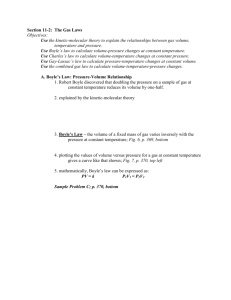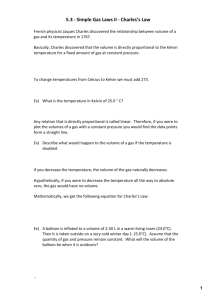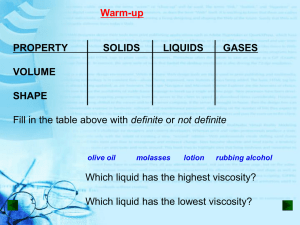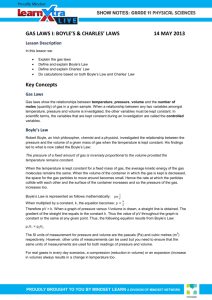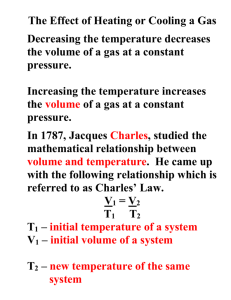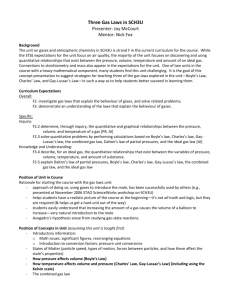Name - The Oakwood School
advertisement
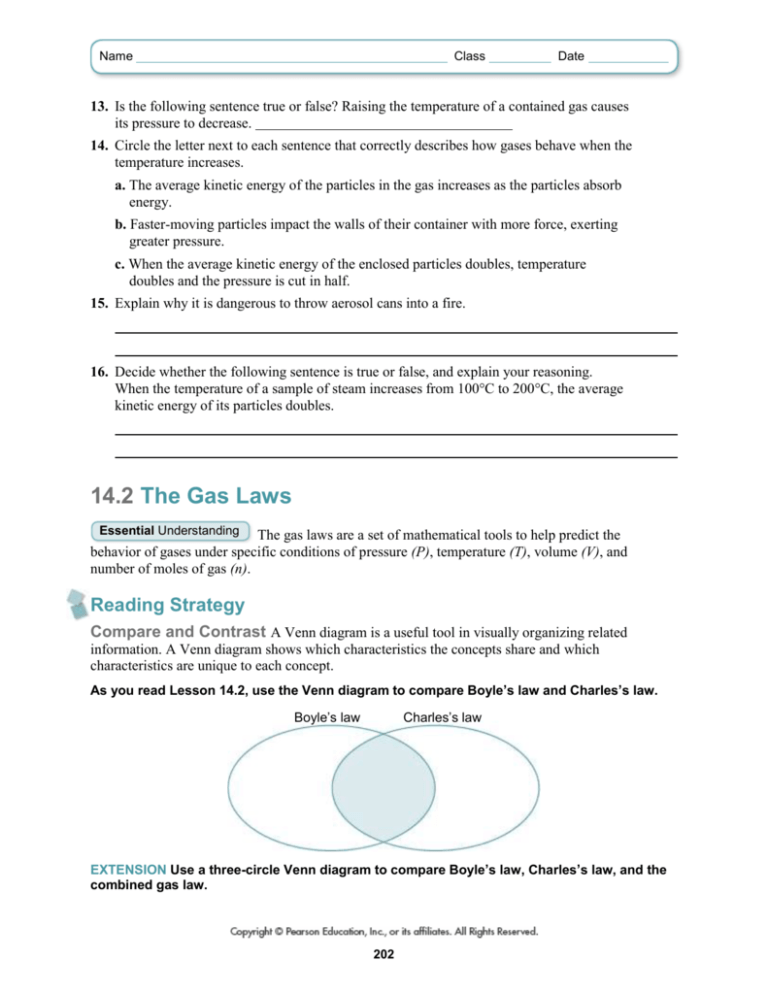
Name Class Date 13. Is the following sentence true or false? Raising the temperature of a contained gas causes its pressure to decrease. 14. Circle the letter next to each sentence that correctly describes how gases behave when the temperature increases. a. The average kinetic energy of the particles in the gas increases as the particles absorb energy. b. Faster-moving particles impact the walls of their container with more force, exerting greater pressure. c. When the average kinetic energy of the enclosed particles doubles, temperature doubles and the pressure is cut in half. 15. Explain why it is dangerous to throw aerosol cans into a fire. 16. Decide whether the following sentence is true or false, and explain your reasoning. When the temperature of a sample of steam increases from 100°C to 200°C, the average kinetic energy of its particles doubles. 14.2 The Gas Laws Essential Understanding The gas laws are a set of mathematical tools to help predict the behavior of gases under specific conditions of pressure (P), temperature (T), volume (V), and number of moles of gas (n). Reading Strategy Compare and Contrast A Venn diagram is a useful tool in visually organizing related information. A Venn diagram shows which characteristics the concepts share and which characteristics are unique to each concept. As you read Lesson 14.2, use the Venn diagram to compare Boyle’s law and Charles’s law. Boyle’s law Charles’s law EXTENSION Use a three-circle Venn diagram to compare Boyle’s law, Charles’s law, and the combined gas law. 202 Name Class Date Lesson Summary Boyle’s Law: Pressure and Volume Boyle’s law states that the pressure and volume of a gas are inversely proportional to each other (constant T, n). The equation for Boyle’s law is P1 × V1 = P2 × V2 Charles’s Law: Temperature and Volume Charles’s law states that the volume of a gas is directly proportional to its Kelvin temperature (constant P, n). The equation for Charles’s law is V1 V2 = T1 T2 Gay-Lussac’s Law: Pressure and Temperature Gay-Lussac’s law states that the pressure of a gas is directly proportional to its Kelvin temperature (constant V, n). P P The equation for Gay-Lussac’s law is 1 = 2 T1 T2 The Combined Gas Law The combined gas law describes the relationship among the pressure, volume, and Kelvin temperature of a gas (constant n). P V P V The equation for the combined gas law is 1 1 = 2 2 T1 T2 Gas law (T) (V) (n) (P) constant ↓ constant ↑ Charles’s law ↑ ↑ constant constant Gay-Lussac’s law ↑ constant constant ↑ Boyle’s law BUILD Math Skills Isolating a Variable Remember that all equations have two sides— a left side and a right side. The first step in isolating a variable is to get any term with the variable in it on one side of the equation. The next step is to get rid of everything else on the same side of the equation as the variable. In order to get rid of the ‘extra’ variables, you must undo its association with that side of the equation. To do this, you do the opposite operation to both sides. Turn to the next page to learn more about isolating a variable. 203 Name Class Date Sample Problem Solve for x in x + 2 = 14. The key to solving this equation is to isolate x. On the left side of the equation, x is added to 2. To undo addition, you must subtract 2 from both sides of the equation. x + 2 = 14 (x + 2) − 2 = 14 − 2 x = 12 Sample Problem Isolate V1 in the equation: V1 V2 = T1 T2 You need to get V1 by itself on the left side. So you need to move T1 to the right side. To undo the division of V1 by T1, you just multiply both sides by T1. Isolate the variables in the problems below. 1. Isolate V2 in the equation: V1 V2 = T1 T2 2. Isolate T2 in the equation: P1 P2 = T1 T2 3. Isolate P2 in the equation: P1 P2 = T1 T2 After reading Lesson 14.2, answer the following questions. Boyle’s Law: Pressure and Volume 4. Circle the letter of each sentence that is true about the relationship between the volume and the pressure of a contained gas at constant temperature? a. When the pressure increases, the volume decreases. b. When the pressure decreases, the volume increases. c. When the pressure increases, the volume increases. d. When the pressure decreases, the volume decreases. 204 Name 5. Class Date law states that for a given mass of gas at constant temperature, the volume of the gas varies inversely with pressure. Questions 6, 7, 8, and 9 refer to the graph. This graph represents the relationship between pressure and volume for a sample of gas in a container at a constant temperature. 6. P1 × V1 = 7. P2 × V2 = 8. P3 × V3 = 9. What do you notice about the product of pressure times volume at constant temperature? Charles’s Law: Temperature and Volume 10. Look at the graph in Figure 14.10. What two observations did Jacques Charles make about the behavior of gases from similar data? 11. What does it mean to say that two variables are directly proportional? 12. Is the following sentence true or false? Charles’s law states that when the pressure of a fixed mass of gas is held constant, the volume of the gas is directly proportional to its Kelvin temperature. 13. Charles’s law may be written V1 V2 at constant pressure if the temperatures are = T1 T2 measured on what scale? Gay-Lussac’s Law: Pressure and Temperature 14. Complete the following sentence. Gay-Lussac’s law states that the pressure of a gas is P1 P2 if the volume is constant and if the T1 T2 temperatures are measured on what scale? 15. Gay-Lussac’s law may be written 205 Name Class Date 16. Complete the missing label in the diagram below showing the pressure change when a gas is heated at constant volume. The Combined Gas Law 17. Is the following sentence true or false? The gas laws of Boyle, Charles, and Gay-Lussac can be combined into a single mathematical expression. Questions 18–21 refer to the following equation: P1 ×V1 P2 ×V2 = T1 T2 18. What law does this mathematical equation represent? 19. Which gas law does this equation represent if temperature is held constant so that T1 = T2? 20. Which gas law does this equation represent if pressure is held constant so that P1 = P2? 21. Which gas law does this equation represent if volume is held constant so that V1 = V2? 22. In which situations does the combined gas law enable you to do calculations when the other gas laws do not apply? 14.3 Ideal Gases Essential Understanding The gas laws are combined into the ideal gas law, which mathematically relates the four gas variables. Lesson Summary Ideal Gas Law The combined gas law can be modified to include the number of moles, n. The ideal gas law is PV = nRT. 206
